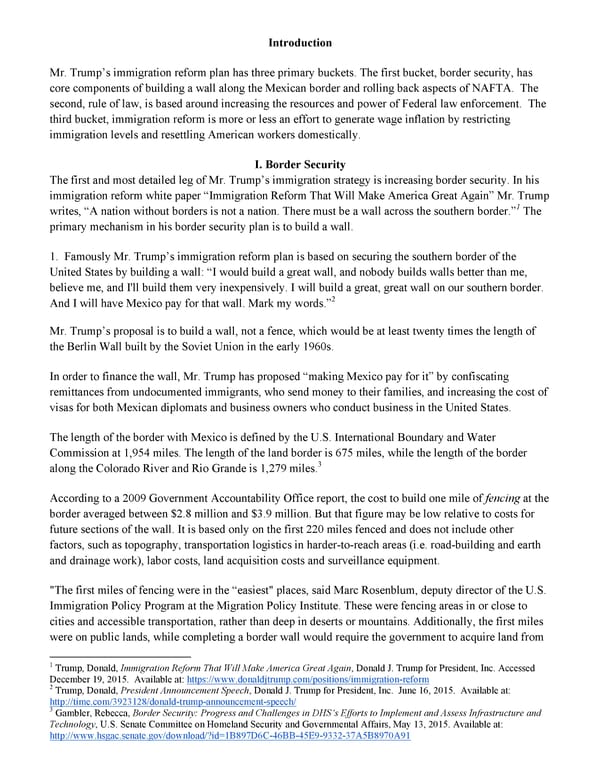Introduction Mr. Trump’s immigration reform plan has three primary buckets. The first bucket, border security, has core components of building a wall along the Mexican border and rolling back aspects of NAFTA. The second, rule of law, is based around increasing the resources and power of Federal law enforcement. The third bucket, immigration reform is more or less an effort to generate wage inflation by restricting immigration levels and resettling American workers domestically. I. Border Security The first and most detailed leg of Mr. Trump’s immigration strategy is increasing border security. In his immigration reform white paper “Immigration Reform That Will Make America Great Again” Mr. Trump writes, “A nation without borders is not a nation. There must be a wall across the southern border.”1 The primary mechanism in his border security plan is to build a wall. 1. Famously Mr. Trump’s immigration reform plan is based on securing the southern border of the United States by building a wall: “I would build a great wall, and nobody builds walls better than me, believe me, and I'll build them very inexpensively. I will build a great, great wall on our southern border. 2 And I will have Mexico pay for that wall. Mark my words.” Mr. Trump’s proposal is to build a wall, not a fence, which would be at least twenty times the length of the Berlin Wall built by the Soviet Union in the early 1960s. In order to finance the wall, Mr. Trump has proposed “making Mexico pay for it” by confiscating remittances from undocumented immigrants, who send money to their families, and increasing the cost of visas for both Mexican diplomats and business owners who conduct business in the United States. The length of the border with Mexico is defined by the U.S. International Boundary and Water Commission at 1,954 miles. The length of the land border is 675 miles, while the length of the border 3 along the Colorado River and Rio Grande is 1,279 miles. According to a 2009 Government Accountability Office report, the cost to build one mile of fencing at the border averaged between $2.8 million and $3.9 million. But that figure may be low relative to costs for future sections of the wall. It is based only on the first 220 miles fenced and does not include other factors, such as topography, transportation logistics in harder-to-reach areas (i.e. road-building and earth and drainage work), labor costs, land acquisition costs and surveillance equipment. "The first miles of fencing were in the “easiest" places, said Marc Rosenblum, deputy director of the U.S. Immigration Policy Program at the Migration Policy Institute. These were fencing areas in or close to cities and accessible transportation, rather than deep in deserts or mountains. Additionally, the first miles were on public lands, while completing a border wall would require the government to acquire land from 1 Trump, Donald, Immigration Reform That Will Make America Great Again, Donald J. Trump for President, Inc. Accessed December 19, 2015. Available at: https://www.donaldjtrump.com/positions/immigration-reform 2 Trump, Donald, President Announcement Speech, Donald J. Trump for President, Inc. June 16, 2015. Available at: http://time.com/3923128/donald-trump-announcement-speech/ 3 Gambler, Rebecca, Border Security: Progress and Challenges in DHS’s Efforts to Implement and Assess Infrastructure and Technology, U.S. Senate Committee on Homeland Security and Governmental Affairs, May 13, 2015. Available at: http://www.hsgac.senate.gov/download/?id=1B897D6C-46BB-45E9-9332-37A5B8970A91
 THE $900 BILLION QUESTION: ILLEGAL IMMIGRATION Page 2 Page 4
THE $900 BILLION QUESTION: ILLEGAL IMMIGRATION Page 2 Page 4